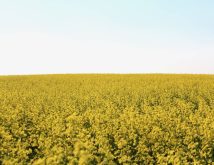After a couple of late springs, western Canadian farmers are poised to start seeding early thanks to above-normal temperatures that star ted in March.
Earlier-seeded crops usually yield better and with farmers planting more acres, many are anxious to get rolling. But before Manitoba farmers hit the fields, they need to think about the potential for a killing frost, says John McGregor, a farm production adviser based in Steinbach.
Some crops can withstand more spring frost than others. And some crops do better in colder soils. When to start seeding is a decision that forces farmers to weigh the benefits and the risks.
Read Also

Manitoba boosts stake in cereals centre to $23.5 million
Premier Wab Kinew said the additional project funds will help ‘Trump-proof’ the provincial economy.
CAUTION
“The biggest caution I would have for guys right now is I’d be checking with my crop insurance agent to make sure if I did seed and I got frozen out are they going to honour my reseeding benefit,” McGregor said in an interview last week.
Manitoba Agricultural Services Commission’s crop insurance contracts don’t specify when farmers can start seeding, but they do state a claim can be rejected if the loss is due to poor farming practices.
Cereal crops will germinate when soil temperatures are 2 C to 3 C and will grow well when the soil is 5 C and above, McGregor said.
Cereal seedlings can also take air temperatures of -5 C to -8 C for a short time.
If the soil is warm enough to germinate cereals and the weather forecast is calling for it to only get warmer, a farmer might decide to plant, even if it’s a bit early according to the calendar.
FROST SURVIVAL
Canola seedlings are usually more susceptible to frost damage, but if they have been “hardened off” through exposure to cooler temperatures they can sometimes survive a bit of frost too, McGregor said.
Spring frosts damaged some Manitoba canola crops in 2009 and 2008, but they were so late farmers couldn’t do anything to avoid it.
“You can’t wait to seed when there’s just a 10 per cent chance of no frost (because you lose too many growing days),” he said. “We never know how big that (seeding) window is going to be.”
Seed treatments are recommended when farmers are planting into cool soils.
In the Steinbach area, there is still a 50 per cent risk of frost as of May 26. That means, on average, temperatures will fall below 0 C once every two years.
Those aren’t great odds, but that doesn’t necessarily mean there will be a killing frost that often. Again, the impact depends on how cold it is, for how long and the crop.
By June 2, the odds of a frost drop to once in four years.
It’s no wonder edible bean growers usually wait until the Victoria Day long weekend to plant.
BETTER TO WAIT
Soybeans can take a bit more frost, but farmers are further ahead to delay planting until
“We never know how big that (seeding)
window is going to be.”
– JOHN MCGREGOR
the soil temperature is 10 C, McGregor said. That way germination is quick and so is emergence, resulting in a strong, even plant stand.
“I’m pretty sure all the soybean guys know that,” he added.
Even in early spring few soybeans are seeded before May 15, McGregor said.
The recent snow and rain will set seeding back about a week in some parts of the province. But once the land is fit to travel on, seeding will begin, he said.
Now is a good time to fertilize winter wheat so long as it doesn’t rut the field.
“With this warm weather that winter wheat is going to start to send out new shoots and be looking for that fertilizer,” McGregor said.
The Canadian Wheat Board (CWB) said last week some seeding of wheat and peas was done in southern Alberta and southwestern Saskatchewan.
Temperatures of 2 C to 12 C above normal have melted most of the snow across the West, the CWB said.
RISKY BUSINESS
Alberta farmers, who are already planting, mainly south of Medicine Hat and Calgary, are willing to risk the return of cold temperatures damaging early-seeded crops, Harry Brook, a crop specialist with the Alberta government told Reuters.
“The only problem is they’re always jumping the gun when it comes to seeding,” he said. “And it germinates and winter comes back and kills it off.”
Most farmers in Saskatchewan won’t think seriously about planting cereals or canola until at least mid-April, said Grant McLean, cropping management specialist for the provincial Agriculture Department.
“Most people in west-central Saskatchewan and up into Alberta are praying for a nice rain.” [email protected]















